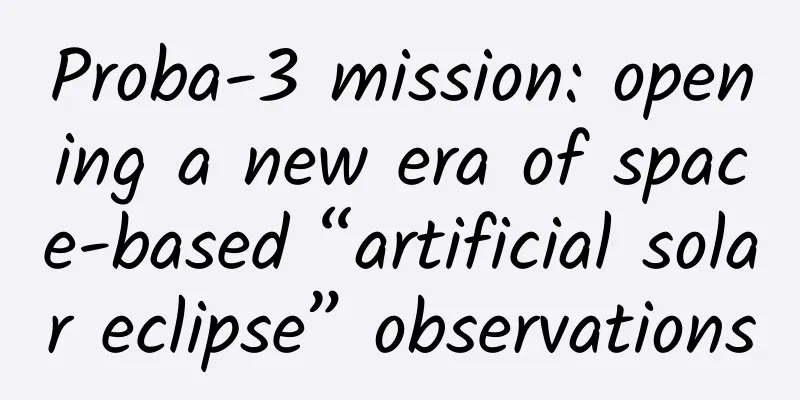Proba-3 mission: opening a new era of space-based “artificial solar eclipse” observations

|
Schematic diagram of the Proba-3 mission. Image credit: ESA-F. Zonno Author: Huang Xianghong Duan Yuechu In the vast journey of exploring the universe, the European Space Agency (ESA) is about to take a groundbreaking step - the Proba-3 mission is scheduled to take off at 18:38 Beijing time on December 4th at the Satish Dhawan Space Center in India. The Proba-3 mission is not simple. It is led by two satellites. Although their total mass is only about 550 kg, they look a bit "small and exquisite", but don't underestimate these two. After they are successfully launched and enter the predetermined orbit, they will go to the Earth's high elliptical orbit, with an apogee of 60,530 kilometers from the Earth and a perigee of 600 kilometers. The orbital inclination is about 59 degrees, like interstellar travelers who have precisely planned their routes and are going to a mysterious date. The two satellites have clear division of labor and can be described as a tacit partner. One of the satellites carries a 1.4-meter-diameter shading disk, like a cosmic "sunshade"; the other is equipped with an advanced coronagraph system, tasked with observing the solar corona. After entering orbit and stable flight, the two started formation flight mode, about 150 meters apart, and adjusted their postures in an orderly manner. Then, a magical scene happened: the satellite carrying the shading disk seized the opportunity and accurately blocked the coronagraph satellite's "view" of the sun, and a space "artificial solar eclipse" was staged magnificently. Observing the solar corona has always been a long-standing problem in the astronomical community. In the past, if you wanted to observe the solar corona in detail, you could only look forward to a total solar eclipse, but this opportunity was pitifully rare. Each total solar eclipse was like a flash in the pan. In just a few minutes, astronomers had just set up their equipment and adjusted the parameters, and before they had time to feast their eyes, the eclipse was over, leaving everyone beating their chests and stamping their feet. The emergence of the Proba-3 mission completely broke this deadlock. Its orbital period is about 19 hours and 36 minutes. What's more surprising is that the duration of the "artificial total solar eclipse" in each cycle can reach about 6 hours, which leaves astronomers with enough observation time, as if the fleeting beauty has been frozen into an ultra-long standby documentary, and it is difficult not to improve the observation accuracy. From the perspective of scientific research, the Proba-3 mission is of great significance. The solar corona has always been shrouded in mystery. As the outer atmosphere of the sun, it has extremely high temperatures and extremely complex material movements. It contains many key clues about solar activity, energy release, and even the evolution of the solar system. In the past, due to the constraints of observation conditions, scientists' understanding of it was like a blind man touching an elephant, fragmented. Now Proba-3 has made continuous and detailed observations a reality, which is undoubtedly a shot of "heart booster" for solar physics research. Professor Smith, an expert from the International Astronomical Union, excitedly stated: "The Proba-3 mission is a milestone breakthrough in the field of astronomy in recent years. It is like opening a door to a new world of corona research for astronomers. In the past, we could only take a few photos during a total solar eclipse and collect limited data. Now we can observe for a long time and in all directions. Many previously unsolved mysteries may soon have answers." Other scholars have boldly speculated that the observation results obtained through Proba-3 are expected to innovate the existing solar storm warning model, allowing humans to prepare in advance and reduce the potential damage of space weather to the Earth's communications and power grids. Looking back at the exploration history of the European Space Agency, the Proba series of satellites have always played a pioneering role, shouldering the heavy responsibility of miniaturized and low-cost space exploration. The Proba-3 mission is a culmination of previous experience, expanding the application boundaries of key technologies such as formation flying and high-precision collaborative control. Although there were many difficulties in the process, from the strict weight reduction requirements of satellite components to the difficulties of precise control algorithms for formation flying, the R&D team has gone through countless times of starting over and staying up late to overcome difficulties, but it is this persistence that makes the dream come true. If the Proba-3 mission is successfully implemented, its impact will radiate to many fields. In terms of education, the vivid "artificial solar eclipse" observation images can enter the classroom, ignite the love of astronomy among young people, and reserve talents for the future; in the aerospace industry, the relevant technology accumulation will feed back to satellite manufacturing, deep space exploration and other projects, and help the vigorous development of commercial aerospace; in the field of popular science, the public's attention to space exploration and solar science will rise, triggering a wave of national exploration of the universe. Today, countless eyes around the world are staring at the Satish Dhawan Space Center, and everyone has the same expectation: May the Proba-3 mission take off and go smoothly, adding another highlight to human understanding of the universe. This space feast carefully prepared by the European Space Agency has just begun, and the follow-up is exciting and worth looking forward to. The road to space exploration is long, and human beings will never stop pursuing the truth of the universe. |
>>: Do elephants hold grudges? Learn about the unknown side of elephants
Recommend
Tencent Advertising Account Opening Standards and Requirements: Open Industry for Individual Advertisers!
Open industry for individual advertisers (I) Entr...
Without the magic in The Three-Body Problem, how can we "broadcast" to the universe? This magical ring is the key!
This year, the science fiction novel "The Th...
Thinking Upgrade-How to Upgrade Thinking Model to Pursue Compound Interest Life
Thinking Upgrade - How to Upgrade Thinking Models...
How to write creative bidding ads!
Today, the competition in online bidding promotio...
The evolution of web-based "application jump" technology
Due to the convenience of web communication, almo...
No matter how effective this thing is in removing formaldehyde, we do not recommend it!
Can ozone be used to remove formaldehyde? In our ...
It’s not wrong to want to “lie down”, the “lazy cancer gene” is innate!
Reviewer: Ji Shi Life Field Observer A quarter of...
Private domain drainage: a comprehensive list of private domain drainage contact points
Every touchpoint between a user and a brand can b...
Why is the annual salary of Gree’s Dong Mingzhu and Lenovo’s Yang Yuanqing 20 times different?
Why is the annual salary of Gree’s Dong Mingzhu a...
Luo Zhixiang is embroiled in a scandal. How can brands provide quick emergency assistance?
When a star falls from grace and is embroiled in ...
Do you need to remove the foam from stewing meat and boiling soup? Note that it is best to skim off these two foams.
This article was reviewed by Liu Shaowei, food sa...
Feeling sleepy and tired in spring? Please check out this spring tea drinking guide
Spring is the season when everything sprouts, and...
WeChat group fission, how to achieve 30,000+ users in 1 day?
“The second half of the Internet ” has been popul...
A case study on efficient advertising and customer acquisition optimization in the beauty industry!
With the development of society, the growth momen...









